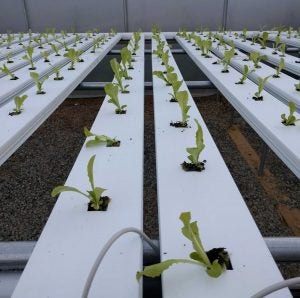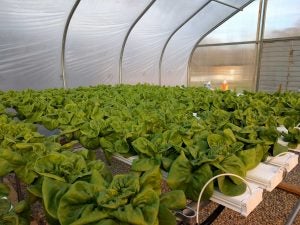Whoever coined the proverb “necessity is the mother of all invention” wasn’t kidding. I’m frequently astounded by the ability of farmers to scrounge together ideas and improvise solutions. Some are one-time creations to get out of a bind, while others have more staying power — perhaps leading to the creation of new implements or farming techniques. Occasionally, necessity prompts the rediscovery of old approaches (making them chic once again) or even births the next wave in farming. Hydroponics is a classic example of ingenuity — one poised to make an indelible mark on today’s food system.
But what is hydroponics? My fav franchise “Star Trek” makes periodic references to a “hydroponics bay” on starships and starbases. Let’s run with that. If I were to suggest that one of the following isn’t necessary to grow plants in the infinite expanse of space, which would it be? Water, air, soil, or light?
Hydroponic (and Earthling) devotees scoff at your soil requirement. As long as a plant has some way to keep itself anchored and upright — and nutrition can be delivered exclusively through a liquid diet of fertilizer water — soil is expendable. That’s the simple definition. The sciencey definition is a medium that lacks cation exchange capacity (CEC). Basically, growing the plant in something that has no ability to attract and hold onto essential nutrients floating around in water. CEC is beneficial because it prevents valuable nutrients from simply washing out of the root zone and out of “pickup contention” by the roots after every rainfall.

You could argue that the few fields of beach sand at my family farm are technically hydroponic. Sand is an inert medium that provides a temporary residence for water (and the nutrients dissolved in them). In other words, sand is arguably not true “soil” because it has no CEC! Real soil has CEC mojo, compliments of clay and organic matter. To improve the poor hand that we’ve been dealt back home, we’ve been spreading leaves and manure to boost the organic matter content of our aspiring sandy soil.
But that’s in the field. Most interest centers on hydroponic systems in controlled environments — and there are many flavors! If you’ve ever been to Disney World, specifically Epcot’s “Living with the Land” pavilion, you’ve seen them in action.
Granted, that’s a high-tech approach. At Florida’s ECHO, a faith-based demonstration farm and training center that combats global hunger, I’ve seen enviable stands of plants grown in kiddie pools filled with pine cones or aluminum cans wrapped in old socks. These act as a makeshift mulch. The bottom of the pools are lined with old carpet that wicks up nutrient solution slow trickled from an upside down barrel with a hole poked in the top. ECHO stresses a concept called “appropriate technology” — leveraging what a developing country already has on hand for maximum impact. And one can repurpose nearly any non-agricultural real estate for family-scale farming!
Plants certainly don’t know the difference between a high or low-tech approach. The roots meander where they need to go to get their “RDA” of nutrients. In a soil setting, roots absorb nutrients dissolved in water (in soil pores) anyway, so why not eliminate the middleman?
The hydroponic setup at my college straddles soil-less simplicity and sophistication. Compliments of a Virginia Tobacco Region Revitalization Commission grant, we have a 30-by-60-foot climate controlled greenhouse equipped with nutrient film technique (NFT) benches to grow specialty lettuce. A custom fertilizer recipe is mixed in water, pumped from a reservoir, and trickled into growing channels (which resemble shallow gutters). Lids on the tops have small spaces to seat plants. The roots dangle down, where they wick up their liquid feed. It’s like an IV for plants. Whatever feed isn’t used is recycled. We can accommodate nearly 1,100 romaine and bibb lettuce plants at a given time. I plant on a weekly staggered basis, just like in the field. And I get to indulge my experimental chops by working with students to tweak things like fertilizer and lighting to optimize production.

There’s something to be said for the glorious reductionism of hydroponics — taking the guesswork out of conventional farming. At the same time, it’s renegotiating conventions. Previously, I’ve pondered the unsubstantiated hype surrounding vertical farming (which typically uses some variant of hydroponics). But it’s not the underlying technique that’s questionable — it’s the sheer scale, capital investment, and voodoo energetics of such an endeavor. Small scale is much more reasonable. And it’s already paying dividends. Already, the campus hydroponic facility has begun to supply the dining hall with a portion of its needs, provide faculty and staff with farm fresh lettuce as part of a wellness initiative, and supply local food banks with nearly a half ton of fresh produce.
Is traditional “dirt farming” a goner? Hardly. But war weary farmers might welcome an infusion of predictability as well as an alternative revenue stream to diversify and manage risk. In a short 20 years, hydroponics has graduated from a curiosity to niche market up-and-comer.
Tim Durham’s family operates Deer Run Farm — a truck (vegetable) farm on Long Island, New York. As an agvocate, he counters heated rhetoric with sensible facts. Tim has a degree in plant medicine and is an Assistant Professor at Ferrum College in Virginia.



